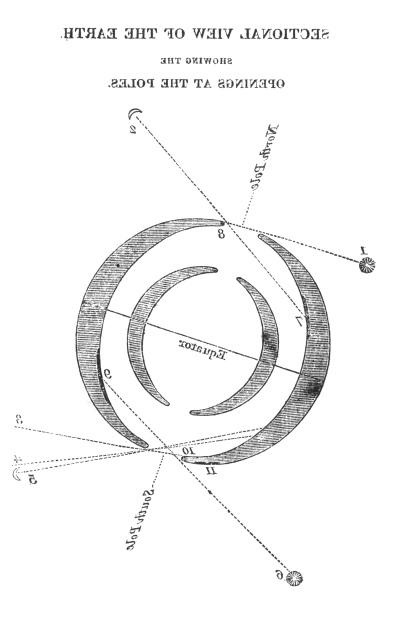By Heather Rockwood, Communications Manager
Part 1 of Journey to the South Pole includes an incomplete timeline of pole travel and looks at the diaries of Charles Francis Adams (CFA, 1807–1886), who was reading a book in 1831 about the southern-most expedition toward the South Pole at that time. It also covers John Quincy Adams’ (JQA, 1767–1848) diary mention of James Byers’ application to Congress for funding of an expedition to settle the South Shetland Islands. These are two typical stories of South Pole expeditions. This next story is unusual.
In 1820, a book was published called Symzonia: Voyage of Discovery, by Captain Adam Seaborn, probably a pseudonym. This sci-fi story is about a journey to the poles, and the discovery that they are an opening into the Earth, which is hollow, and inhabitable. Explorer Jeremiah N. Reynolds (1799–1858) heard about the book’s theory from John Cleves Symmes (1780–1829), who is considered to be the real author of the book. Reynolds then made numerous petitions to Congress for funding an expedition to the South Pole, according to The Maritime Studies Program of Williams College & Mystic Seaport, although he and Symmes parted ways soon after his petitions began.

CFA notes that he met with Reynolds on 21 April 1827, while Reynolds was in Washington lecturing and lobbying for the expedition to the South Pole: “In the evening, Reynolds, the expedition man, called to see me and drew me out of myself for an hour.” CFA wrote about him again a few days later on 29 April 1827: “Particularly in reading some papers of Mr. Reynolds upon the subject of his expedition. I think him very clever, but without polish to make it tell as it ought.” He did not have faith in Reynolds abilities to convince Congress.
On 22 February 1828, President JQA wrote a note about a ball he attended that evening, at which he met Reynolds: “I met at the Ball, besides other Strangers, Mr Reynolds the projector of an expedition to the South-Pole.” On 13 June 1828, JQA notes that “Mr Reynolds the projector of an Expedition to the South Pole was here— A Bill for that purpose was reported by the Naval Committee to the House of Representatives at their last Session, but the House could not reach it in Season—A Resolution of the House did pass however recommending that one of the Public Vessels should be employed on an exploring Expedition to the South-Sea— Reynolds says that a Merchant brig, will be sent with her upon Speculation.” Following up on this, in JQA’s diary on 17 November 1828, he wrote: “Southard Saml. L. The South Pole Expedition— Jones to command—Instruments to be purchased.” Reynolds’ petition was successful; however, the funding disappeared when JQA lost the presidential election to Andrew Jackson in 1829.
Reynolds then succeeded in gaining private funding for the expedition which started in 1829, with Reynolds aboard the ship. The voyage reached the Palmer Peninsula of Antarctica, but then turned back. When the ship reached Chile, the crew mutinied and left Reynolds behind. He spent two years in Chile until the US frigate Potomac brought him back to the United States.
Reynold’s tale does not end here. Watch for Journey to the South Pole, Part 3, where Reynolds tale will end and JQA meets a man with a scientific theory about the pole’s magnetism. Further reading: Tales of a Hollow Earth: Tracing the Legacy of John Cleves Symmes in Antarctic Exploration and Fiction, by L. I. Chaplow, 2011, a thesis submitted in partial fulfilment of the requirements of the Degree of Masters of Antarctic Studies at the University of Canterbury.

